(→Mixed Bottles: Lost Coast Brewery in Eureka, California) |
Sophivorus (talk | contribs) m (Replace references template for plain references tag per better compatibility with visual editor and other software) |
||
| (41 intermediate revisions by 7 users not shown) | |||
| Line 1: | Line 1: | ||
{{ | [[File:CO2 Emissions of a Washed Bottle (1).png|thumb|]] | ||
{{Project data}} | |||
The research project was a collaboration between [[Cal Poly Humboldt]]'s [[Engr308 Technology and the Environment]] and Zero Waste Humboldt (ZWH) during the Fall of 2019. The client liaison on this project is | |||
* Maggie Gainer, Zero Waste Humboldt | * Maggie Gainer, Zero Waste Humboldt | ||
The objective of this project is to analyze and compare | The objective of this project is to analyze and compare the impacts of recycling beer bottles to local beer bottle washing in the terms of embedded [[carbon dioxide]] emissions and [[embedded energy]]. While researching, we were able to conduct a comparative examination between the life cycle analysis' for both recycled bottles and washed bottles. The glass beer bottles we used for observation were from Lost Coast Brewery in Humboldt County. | ||
== Findings == | |||
[[File:Embedded Energy of Mixed Versus Washed Bottles.png|thumb|left|Embedded energy of the production of a single mixed bottle versus a single washed bottle. Source as produced by [[File:Bottle Washing Analysis.xlsx|Bottle Washing Analysis]].]] | |||
[[File:Embedded CO2 of Mixed Versus Washed Bottles.png|thumb|left|Embedded CO2 of the production of a single mixed bottle versus a single washed bottle. Source as produced by [[File:Bottle Washing Analysis.xlsx|Bottle Washing Analysis]].]] | |||
[[File: | |||
This study of Virgin Bottles, Mixed Bottles, and Washed Bottles compared two metrics: carbon dioxide emissions and embedded energy. It was concluded that the materials used, the transport of, and packaging of a single beer bottle requires 0.72 kilowatt-hours of energy and is responsible for 0.323 pounds of carbon dioxide emissions. In comparison, a single mixed bottle is responsible for using 0.69 kilowatt-hours of energy, releasing 0.306 pounds of carbon dioxide. A single washed bottle is responsible for using 0.021 kilowatt-hours of energy, releasing 0.010 pounds of carbon dioxide emissions. | |||
The assumptions used to obtain these results can be seen below in further detail in the section titled [[#Caveats|Caveats]]. | |||
{| class="wikitable" | |||
! | |||
! | |||
! Virgin Bottles | ! Virgin Bottles | ||
! Mixed Bottles | ! Mixed Bottles | ||
| Line 29: | Line 34: | ||
| 0.306 | | 0.306 | ||
| 0.010 | | 0.010 | ||
|} | |} | ||
Based on the numbers shown above, we are able to conduct a comparative analysis showing the embedded energy and CO<sub>2</sub> between a single mixed bottle and a single washed bottle. The calculations and assumptions used to aquire these results can be seen in further detail in the following spreadsheet: | |||
* [[File: Bottle Washing Analysis.xlsx|Bottle Washing Analysis]] | |||
The spreadsheet allows for others interested in performing a similar analysis to easily input values pertaining to their particular study area. It is our hope that with this information and the pre-assembled spreadsheet, other institutions will be able to reach similar compelling conclusions that have the potential to influence future policies. | |||
The spreadsheet allows for others interested in performing a similar analysis to easily input values pertaining to their particular study area. It is our hope that with this information and the pre-assembled spreadsheet, other institutions will be able to reach similar compelling conclusions that have the potential to influence future | |||
=== Virgin Bottles === | |||
[[File:EE Energy Virgin Bottle.png|thumb|Embedded energy in the production of a virgin beer bottle by source as produced by [[File:Bottle Washing Analysis.xlsx|Bottle Washing Analysis]].]] | |||
[[File:CO2 Emissions of a Virgin Bottle.png|thumb|Carbon Dioxide emissions from the production of a virgin beer bottle by source as produced by [[File:Bottle Washing Analysis.xlsx|Bottle Washing Analysis]].]] | |||
The bottles analyzed in this study were 12oz glass bottles, produced by a company in Los Angeles, California and then transported to Lost Coast Brewery in Eureka, California. We measured embedded energy of a virgin bottle by accounting for materials, transportation, and packaging. A virgin bottle is defined as a bottle that has completely new materials. Therefore, the life cycle analysis was determined through the manufacturing processes necessary for the creation of a new glass bottle. The embedded carbon dioxide comes from the melting of materials, heating water, and other CO<sub>2</sub> emitted during transportation. The embedded energy for a virgin bottle is 0.72 kWh/bottle and releases 0.323 pounds of CO<sub>2</sub> | |||
The | |||
{| class="wikitable" | {| class="wikitable" | ||
! Output | |||
! | |||
! Embedded Energy | ! Embedded Energy | ||
! Carbon Dioxide Emissions | ! Carbon Dioxide Emissions | ||
|- | |- | ||
| Materials | | Materials | ||
| | | 0.63 kWh/bottle | ||
| 0. | | 0.269 lb CO<sub>2</sub>/bottle | ||
|- | |- | ||
|Transportation | | Transportation | ||
| 0. | | 0.086 kWh/bottle | ||
| 0. | | 0.051 lb CO<sub>2</sub>/bottle | ||
|- | |- | ||
| | | Packaging | ||
| 0.007 kWh/bottle | | 0.007 kWh/bottle | ||
| 0.003 lb CO<sub>2</sub>/bottle | | 0.003 lb CO<sub>2</sub>/bottle | ||
|- | |- | ||
! Total (1 bottle) | |||
! 0.72 kWh/bottle | |||
! 0.323 lb CO<sub>2</sub>/bottle | |||
|- | |- | ||
! Total (100,000 bottles sold) | |||
! 72,487 kWh | |||
! 32,286 lb CO<sub>2</sub> | |||
|} | |} | ||
===Mixed Bottles=== | === Mixed Bottles === | ||
[[File: | |||
[[File: | [[File:EE of Mixed Bottle.png|thumb|Embedded energy in the production of a mixed beer bottle by source as produced by [[File:Bottle Washing Analysis.xlsx|Bottle Washing Analysis]].]] | ||
The recycled bottles analyzed in this study were the 12oz | |||
[[File:CO2 Emissions of a Mixed Bottles.png|thumb|Carbon Dioxide emissions from the production of a mixed beer bottle by source as produced by [[File:Bottle Washing Analysis.xlsx|Bottle Washing Analysis]].]] | |||
The recycled bottles analyzed in this study were the 12oz glass bottles from Lost Coast Brewery in Eureka, California. These bottles were produced by the company Saxco based out of Sacramento, California and were transported to Lost Coast Brewery in Eureka, California. It was estimated that 20% of all the bottles purchased were recycled. This is a user input that we assumed based on dialog with Lost Coast Brewery and is changeable on the spreadsheet. As recycled materials are made into bottles again, the melting process was found to be similar to creating a virgin bottle. It takes a similar process and emits a little under that of a virgin bottle. Further, the transportation was less in a recycled bottle because of the difference in distance. The embedded energy a mixed bottle was 0.69 kWh/bottle and released 0.306 pounds of carbon dioxide emissions. | |||
{| class="wikitable" | {| class="wikitable" | ||
! Output | |||
! | |||
! Embedded Energy | ! Embedded Energy | ||
! Carbon Dioxide Emissions | ! Carbon Dioxide Emissions | ||
|- | |- | ||
| Materials | | Materials | ||
| 0. | | 0.60 kWh/bottle | ||
| 0. | | 0.252 lb CO<sub>2</sub>/bottle | ||
|- | |- | ||
|Transportation | | Transportation | ||
| 0. | | 0.086 kWh/bottle | ||
| 0. | | 0.051 lb CO<sub>2</sub>/bottle | ||
|- | |- | ||
| | | Packaging | ||
| 0.007 kWh/bottle | | 0.007 kWh/bottle | ||
| 0.003 lb CO<sub>2</sub>/bottle | | 0.003 lb CO<sub>2</sub>/bottle | ||
|- | |- | ||
! Total (1 bottle) | |||
! 0.69 kWh/bottle | |||
! 0.306 lb CO<sub>2</sub>/bottle | |||
|- | |- | ||
! Total (100,000 bottles sold) | |||
! 68,942 kWh | |||
! 30,592 lb CO<sub>2</sub> | |||
|} | |} | ||
===Washed Bottles=== | === Washed Bottles === | ||
[[File: | |||
[[File: | [[File:Embedded Energy of a Washed Bottle.png|thumb|Embedded energy in washed bottles (including making the bottle and washing it 35 times) by source (note that materials include the washing process) as produced by [[File:Bottle Washing Analysis.xlsx|Bottle Washing Analysis]].]] | ||
[[File:CO2 Emissions of a Washed Bottle (1).png|thumb|Carbon Dioxide emissions from washed bottles (including making the bottle and washing it 35 times) by source (note that materials include the washing process) as produced by [[File:Bottle Washing Analysis.xlsx|Bottle Washing Analysis]].]] | |||
We predicted that the bottles being washed were 20% recycled bottles to begin with (although the bottle might need to be thicker for washing, which would raise the embedded energy and CO2 somewhat). It was assumed that transportation would not emit extra energy for a washed bottles because consumers could drop off their bottles during a regular shopping trip. Embedded energy and CO2 came from each time a new or recycled bottle was made, along with the process of running the bottle washing machine. The amount of times a bottle can be re-washed ranges from 25 to 50 times and is a number a user can input - we used 35 for the following findings. The embedded energy in a washed bottle is 0.021 kWh/bottle and releases 0.010 carbon dioxide emissions. | |||
{| class="wikitable" | {| class="wikitable" | ||
! Output | |||
! | |||
! Embedded Energy | ! Embedded Energy | ||
! Carbon Dioxide Emissions | ! Carbon Dioxide Emissions | ||
|- | |- | ||
| Materials | | Materials | ||
| 0. | | 0.019 kWh/bottle | ||
| 0. | | 0.008 lb CO<sub>2</sub>/bottle | ||
|- | |- | ||
|Transportation | | Transportation | ||
| 0.002 kWh/bottle | | 0.002 kWh/bottle | ||
| 0. | | 0.002 lb CO<sub>2</sub>/bottle | ||
|- | |- | ||
| | | Packaging | ||
| | | 0.00 kWh/bottle | ||
| | | 0.00 lb CO<sub>2</sub>/bottle | ||
|- | |- | ||
! Total (1 bottle) | |||
! 0.021 kWh/bottle | |||
! 0.010 lb CO<sub>2</sub>/bottle | |||
|- | |- | ||
! Total (for 100,000 bottles sold) | |||
! 2,141 kWh | |||
! 1,039 lb CO<sub>2</sub> | |||
|} | |} | ||
== | == Research Synthesis == | ||
==== Embedded Energy, CO<sub>2</sub> Emissions in Materials ==== | |||
====Embedded Energy, CO<sub>2</sub> Emissions in Materials==== | |||
During the Fall of 2019, Humboldt | During the Fall of 2019, Cal Poly Humboldt chose to support the Zero Waste Humboldt, specializing in providing waste reduction solutions | ||
through public education, advocacy, and technical assistance and training <ref>https://zerowastehumboldt.org/</ref> | through public education, advocacy, and technical assistance and training,<ref>http://web.archive.org/web/20210123144400/https://zerowastehumboldt.org/</ref> to end the use of transporting beer bottles to be recycled and to promote local bottle washing. This project hopes to influence Lost Coast Brewery's possibility of investing in a bottle washing machine. Students in ENRG 308, kept in contact with Scot, the manager of Lost Coast brewery, to determine factors such as bottle sold, materials, and where shipments go etc. By analyzing the materials used, transportation, and the packaging, we were able to determine embedded energy and carbon dioxide emissions within a virgin, recycled, and washed beer bottle. This type of bottle washing is a common practice in many European countries and our findings show why. The energy used to wash a bottle is far less than a mixed bottle consisting of virgin and recycling materials. This literature review will go over the embedded energy and CO<sub>2</sub> emissions of the individual products, the energy, and carbon impact of transporting the products, as well as creating a total energy and carbon dioxide impact of the product once the virgin bottle is bought. | ||
Embodied or embedded energy (EE) is defined as the energy used during the entire life cycle of a product. For example, the EE of a virgin bottle or mixed bottle could include extraction and processing of raw materials, manufacturing, transportation, distribution, use, reuse, recycling. Assuming that in all cased disposal is needed, this was kept out. The process of returning a used bottle to Lost Coast Brewery is assumed that it takes no extra transportation. This was a portion of EE calculations for the three bottle types. And if a bottle washing machine was purchased by Lost Coast Brewery, people who drop off bottles would be coming for more than just a drop-off. | Embodied or embedded energy (EE) is defined as the energy used during the entire life cycle of a product. For example, the EE of a virgin bottle or mixed bottle could include extraction and processing of raw materials, manufacturing, transportation, distribution, use, reuse, recycling. Assuming that in all cased disposal is needed, this was kept out. The process of returning a used bottle to Lost Coast Brewery is assumed that it takes no extra transportation. This was a portion of EE calculations for the three bottle types. And if a bottle washing machine was purchased by Lost Coast Brewery, people who drop off bottles would be coming for more than just a drop-off. EE calculations are used to conduct [[life cycle assessment]]s (LCA). LCA is a well-explored concept and has been used as an environmental management tool since the late 1960's.<ref>Menzies, Gillian F., Seyhan Turan, and Philip FG Banfill. "Life-cycle assessment and embodied energy: a review."Proceedings of the Institution of Civil Engineers-Construction Materials 160.4 (2007): 135-144</ref> LCA provides a tool for evaluating the relative environmental impact of various materials and calculates externalities otherwise excluded from pricing. Our LCA will include emissions and the EE of the materials and shipping.<ref>http://buildingsdatabook.eren.doe.gov/TableView.aspx?table=Notes/</ref> | ||
Some background information: | Some background information: | ||
* [https:///www.lostcoast.com/ Lost Coast Brewery] | * [https:///www.lostcoast.com/ Lost Coast Brewery] | ||
====Embedded Energy and CO<sub>2</sub> Emissions in materials==== | ==== Embedded Energy and CO<sub>2</sub> Emissions in materials ==== | ||
Embedded Energy and CO<sub>2</sub> emissions of Virgin Bottle Material | |||
Embedded Energy | {| class="wikitable" | ||
! Material | |||
! Embedded Energy (kWh/bottle) | |||
! CO<sub>2</sub> Emissions (lb CO<sub>2</sub>/bottle) | |||
|- | |||
| Sand | |||
| 0.057 | |||
| 0.026 | |||
|- | |||
| Limestone | |||
| 0.002 | |||
| 0.001 | |||
|- | |||
| Feldspar | |||
| 0.017 | |||
| 0.008 | |||
|- | |||
| Soda Ash | |||
| 0.130 | |||
| 0.060 | |||
|- | |||
| Virgin Melting | |||
| 0.644 | |||
| 0.295 | |||
|- | |||
! Total | |||
| 0.850 | |||
| 0.390 | |||
|} | |||
'''Mixed Bottles and Washed Bottles''' | '''Mixed Bottles and Washed Bottles''' | ||
* The mixed bottles are made up the Virgin bottle material along with a mixed amount of recycled amber glass material. Here are the materials broken down: | |||
*Sand: 70% of a new bottle is made up of sand | * Sand: 70% of a new bottle is made up of sand | ||
*Soda Ash: Around 2% of soda ash is used in creating a bottle. Soda ash plays a vital role to reduce the furnace temperature necessary to melt the silica used. This reduces the energy required to produce the glass. | * Soda Ash: Around 2% of soda ash is used in creating a bottle. Soda ash plays a vital role to reduce the furnace temperature necessary to melt the silica used. This reduces the energy required to produce the glass. | ||
*Feldspar: Each bottle is about 8% feldspar | * Feldspar: Each bottle is about 8% feldspar | ||
*Limestone: Each bottle is about 15% Limestone | * Limestone: Each bottle is about 15% Limestone | ||
*Recycled amber glass: The amount of glass that is recycled in a recycled bottle is normally around 80% of the bottle | * Recycled amber glass: The amount of glass that is recycled in a recycled bottle is normally around 80% of the bottle | ||
==== Embedded Energy and CO<sub>2</sub> Emissions in Transportation ==== | |||
'''Transport by Land''' | '''Transport by Land''' | ||
For Trucks the Fuel efficiency of Class 8 Truck by Vehicle Weight Range on Flat Terrain at 65 mph 9.2 miles/gal <ref name="cta">http://cta.ornl.gov/vtmarketreport/pdf/chapter3_heavy_trucks.pdf</ref> which we then convert into km which is 14.8 km/gal. | For Trucks the Fuel efficiency of Class 8 Truck by Vehicle Weight Range on Flat Terrain at 65 mph 9.2 miles/gal<ref name="cta">http://cta.ornl.gov/vtmarketreport/pdf/chapter3_heavy_trucks.pdf</ref> which we then convert into km which is 14.8 km/gal. | ||
*For Diesel Fuel | * For Diesel Fuel | ||
**Energy | ** Energy intensity: 135.8 MJ/gal<ref>https://www.extension.iastate.edu/agdm/wholefarm/pdf/c6-87.pdf</ref> | ||
** Carbon Intensity 10.15 kg CO<sub>2</sub> /gal<ref name= "EIA">http://www.eia.gov/tools/faqs/faq.cfm?id=307&t=11</ref> | |||
**Carbon Intensity 10.15 kg CO<sub>2</sub> /gal <ref name= | * General embedded energy in shipping by land<ref>http://pubs.acs.org/doi/pdf/10.1021/es702969f</ref> | ||
*General embedded energy in shipping by land <ref>http://pubs.acs.org/doi/pdf/10.1021/es702969f</ref> | |||
traveled by truck: 2.7 MJ/ t-km | traveled by truck: 2.7 MJ/ t-km | ||
Traveled by Truck: 180 (t CO<sub>2</sub>E / t-km x 10^6) | Traveled by Truck: 180 (t CO<sub>2</sub>E / t-km x 10^6) | ||
36.63 MJ/vehicle km<ref>http://cta.ornl.gov/data/chapter2.shtml </ref> | 36.63 MJ/vehicle km<ref>http://cta.ornl.gov/data/chapter2.shtml</ref><ref>http://www.dot.ca.gov/trafficops/trucks/quickguide.html</ref> | ||
<ref>http://www.dot.ca.gov/trafficops/trucks/quickguide.html</ref> | |||
General embedded CO<sub>2</sub> in shipping by land | General embedded CO<sub>2</sub> in shipping by land | ||
80 g/tonne/km<ref> http://www.ics-shipping.org/docs/co2,</ref> | 80 g/tonne/km<ref>http://www.ics-shipping.org/docs/co2,</ref> | ||
====Embedded Energy and CO<sub>2</sub> Emissions in Materials==== | ==== Embedded Energy and CO<sub>2</sub> Emissions in Materials ==== | ||
It was found that Humboldt County transfers their beer bottles to Sacramento California and/or Los Angeles, California. | It was found that Humboldt County transfers their beer bottles to Sacramento California and/or Los Angeles, California.<ref>https://humboldtgov.org/DocumentCenter/View/4203</ref> | ||
The efficiency for a variety of trash trucks was averaged at 3 miles per gallon which was then converted to km instead of miles<ref>http://www.cert.ucr.edu/events/pems2014/liveagenda/25sandhu.pdf</ref> which ended being 4.8 km/gal. | The efficiency for a variety of trash trucks was averaged at 3 miles per gallon which was then converted to km instead of miles<ref>http://www.cert.ucr.edu/events/pems2014/liveagenda/25sandhu.pdf</ref> which ended being 4.8 km/gal. | ||
| Line 221: | Line 233: | ||
Diesel Energy intensity: 135.8 MJ/gal<ref>https://www.extension.iastate.edu/agdm/wholefarm/pdf/c6-87.pdf</ref> | Diesel Energy intensity: 135.8 MJ/gal<ref>https://www.extension.iastate.edu/agdm/wholefarm/pdf/c6-87.pdf</ref> | ||
Carbon Intensity 10.15 kg CO<sub>2</sub> /gal <ref>http://www.eia.gov/tools/faqs/faq.cfm?id=307&t=11</ref> | Carbon Intensity 10.15 kg CO<sub>2</sub> /gal<ref>http://www.eia.gov/tools/faqs/faq.cfm?id=307&t=11</ref> | ||
== Caveats == | |||
* To obtain the numbers for the total embedded energy and total CO<sub>2</sub> for washed bottles, we assumed that 20% of the bottle was recycled material. This assumptions can be easily changed to any % recycled content in the spreadsheet. | |||
* We did not include labels because the comparison would have been the same, as all bottles have labels. | |||
* We assumed that the trucks were 100% full each time when transporting bottles to Lost Coast Brewery. | |||
* For bottle washing we used the XP1 (with a 6000 bottles/hour capacity) machine and assumed a 12 hours per day workload and that the water will stay warm for that entire time. When selecting a bottle washing machine, these assumptions will need to be refined based upon that machine's specifications. | |||
* We did not include the transportation of the raw and recycled materials. | |||
* We did not include the slightly extra embedded energy needed to manufacture a thicker glass bottle for washing. | |||
== Next Steps == | |||
After completing the initial analysis, there are various alterations to the methods that could be made to create even more accurate results. These include: | |||
* What are people's methods of washing the bottles? Is it significant enough to change the final outputs? | |||
* Determine the volume of waste avoided by the implementation of a policy such as this. | |||
*What are people's methods of washing the bottles? Is it significant enough to change the final outputs | * Calculate the embedded energy and carbon dioxide emissions in each unit produced by the manufacturing facilities, and the acquisition of the raw materials. | ||
* Explore alternate options as to whether or not other viable products have the potential to reduce the embedded energy or carbon dioxide emissions from the bottles. | |||
* Determine outlets for promoting and distributing this research to make it widely accessible. | |||
*Determine the volume of waste avoided by the implementation of a policy such as this. | * Partnership with other CSUs to strive towards waste, energy, and CO2 reduction initiatives. | ||
*Calculate the embedded energy and carbon dioxide emissions in each unit produced by the manufacturing facilities, and the acquisition of the raw materials. | |||
*Explore alternate options as to whether or not other viable products have the potential to reduce the embedded energy or carbon dioxide emissions from the bottles. | |||
*Determine outlets for promoting and distributing this research to make it widely accessible. | |||
*Partnership with other CSUs to strive towards waste, energy, and CO2 reduction initiatives. | |||
== | == Teams == | ||
* '''Bottle Washing Bosses:''' Andrew Braswell, Ileana Spoelstra, Kelly Randazzo, Anthony Pigone | |||
* '''Bad News Beers:''' [[User:Emilyread|Emily Read]], [[User:Inesm|Ines Morales]], [[User:Aws216|Austin Sani]], [[User:Cad748|Clarissa Duron]] | |||
* '''Team 3:''' Gabe Kim, Kaitlyn McGinnis,Cassidy Mullennix | |||
* '''Brainstorm Boys:''' Bret Buck, Ivan Ramirez, Dale Ebersole | |||
* '''Bottle Washing Beaches (Meta Team):''' [[User:Alexe31|Alexandria Eastburn]], [[User:Sarajune|Sara June]], [[User:HappinessOnEarth|Alyssa Della Ripa]] | |||
== | == References == | ||
<references /> | |||
{{Page data}} | |||
[[Category:Life cycle analysis]] | |||
[[Category:Engr308 Technology and the Environment]] | |||
Latest revision as of 19:21, 8 June 2023
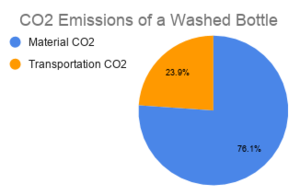
The research project was a collaboration between Cal Poly Humboldt's Engr308 Technology and the Environment and Zero Waste Humboldt (ZWH) during the Fall of 2019. The client liaison on this project is
- Maggie Gainer, Zero Waste Humboldt
The objective of this project is to analyze and compare the impacts of recycling beer bottles to local beer bottle washing in the terms of embedded carbon dioxide emissions and embedded energy. While researching, we were able to conduct a comparative examination between the life cycle analysis' for both recycled bottles and washed bottles. The glass beer bottles we used for observation were from Lost Coast Brewery in Humboldt County.
Findings[edit | edit source]
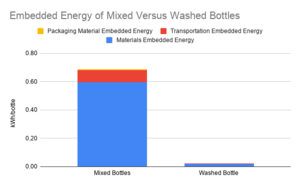
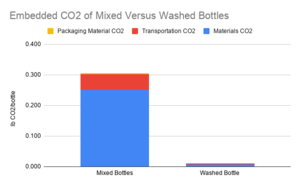
This study of Virgin Bottles, Mixed Bottles, and Washed Bottles compared two metrics: carbon dioxide emissions and embedded energy. It was concluded that the materials used, the transport of, and packaging of a single beer bottle requires 0.72 kilowatt-hours of energy and is responsible for 0.323 pounds of carbon dioxide emissions. In comparison, a single mixed bottle is responsible for using 0.69 kilowatt-hours of energy, releasing 0.306 pounds of carbon dioxide. A single washed bottle is responsible for using 0.021 kilowatt-hours of energy, releasing 0.010 pounds of carbon dioxide emissions.
The assumptions used to obtain these results can be seen below in further detail in the section titled Caveats.
| Virgin Bottles | Mixed Bottles | Washed Bottles | |
|---|---|---|---|
| Embedded Energy (kWh/bottle) | 0.72 | 0.69 | 0.021 |
| Carbon Dioxide (lbs/bottle) | 0.323 | 0.306 | 0.010 |
Based on the numbers shown above, we are able to conduct a comparative analysis showing the embedded energy and CO2 between a single mixed bottle and a single washed bottle. The calculations and assumptions used to aquire these results can be seen in further detail in the following spreadsheet:
The spreadsheet allows for others interested in performing a similar analysis to easily input values pertaining to their particular study area. It is our hope that with this information and the pre-assembled spreadsheet, other institutions will be able to reach similar compelling conclusions that have the potential to influence future policies.
Virgin Bottles[edit | edit source]
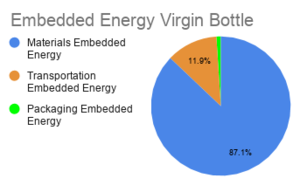
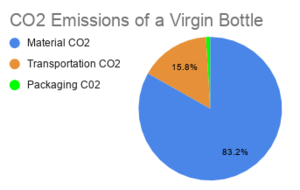
The bottles analyzed in this study were 12oz glass bottles, produced by a company in Los Angeles, California and then transported to Lost Coast Brewery in Eureka, California. We measured embedded energy of a virgin bottle by accounting for materials, transportation, and packaging. A virgin bottle is defined as a bottle that has completely new materials. Therefore, the life cycle analysis was determined through the manufacturing processes necessary for the creation of a new glass bottle. The embedded carbon dioxide comes from the melting of materials, heating water, and other CO2 emitted during transportation. The embedded energy for a virgin bottle is 0.72 kWh/bottle and releases 0.323 pounds of CO2
| Output | Embedded Energy | Carbon Dioxide Emissions |
|---|---|---|
| Materials | 0.63 kWh/bottle | 0.269 lb CO2/bottle |
| Transportation | 0.086 kWh/bottle | 0.051 lb CO2/bottle |
| Packaging | 0.007 kWh/bottle | 0.003 lb CO2/bottle |
| Total (1 bottle) | 0.72 kWh/bottle | 0.323 lb CO2/bottle |
| Total (100,000 bottles sold) | 72,487 kWh | 32,286 lb CO2 |
Mixed Bottles[edit | edit source]
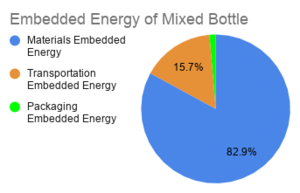
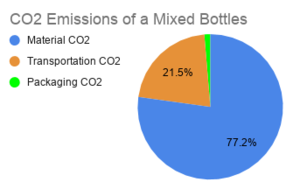
The recycled bottles analyzed in this study were the 12oz glass bottles from Lost Coast Brewery in Eureka, California. These bottles were produced by the company Saxco based out of Sacramento, California and were transported to Lost Coast Brewery in Eureka, California. It was estimated that 20% of all the bottles purchased were recycled. This is a user input that we assumed based on dialog with Lost Coast Brewery and is changeable on the spreadsheet. As recycled materials are made into bottles again, the melting process was found to be similar to creating a virgin bottle. It takes a similar process and emits a little under that of a virgin bottle. Further, the transportation was less in a recycled bottle because of the difference in distance. The embedded energy a mixed bottle was 0.69 kWh/bottle and released 0.306 pounds of carbon dioxide emissions.
| Output | Embedded Energy | Carbon Dioxide Emissions |
|---|---|---|
| Materials | 0.60 kWh/bottle | 0.252 lb CO2/bottle |
| Transportation | 0.086 kWh/bottle | 0.051 lb CO2/bottle |
| Packaging | 0.007 kWh/bottle | 0.003 lb CO2/bottle |
| Total (1 bottle) | 0.69 kWh/bottle | 0.306 lb CO2/bottle |
| Total (100,000 bottles sold) | 68,942 kWh | 30,592 lb CO2 |
Washed Bottles[edit | edit source]
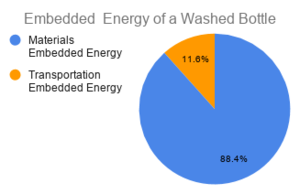

We predicted that the bottles being washed were 20% recycled bottles to begin with (although the bottle might need to be thicker for washing, which would raise the embedded energy and CO2 somewhat). It was assumed that transportation would not emit extra energy for a washed bottles because consumers could drop off their bottles during a regular shopping trip. Embedded energy and CO2 came from each time a new or recycled bottle was made, along with the process of running the bottle washing machine. The amount of times a bottle can be re-washed ranges from 25 to 50 times and is a number a user can input - we used 35 for the following findings. The embedded energy in a washed bottle is 0.021 kWh/bottle and releases 0.010 carbon dioxide emissions.
| Output | Embedded Energy | Carbon Dioxide Emissions |
|---|---|---|
| Materials | 0.019 kWh/bottle | 0.008 lb CO2/bottle |
| Transportation | 0.002 kWh/bottle | 0.002 lb CO2/bottle |
| Packaging | 0.00 kWh/bottle | 0.00 lb CO2/bottle |
| Total (1 bottle) | 0.021 kWh/bottle | 0.010 lb CO2/bottle |
| Total (for 100,000 bottles sold) | 2,141 kWh | 1,039 lb CO2 |
Research Synthesis[edit | edit source]
Embedded Energy, CO2 Emissions in Materials[edit | edit source]
During the Fall of 2019, Cal Poly Humboldt chose to support the Zero Waste Humboldt, specializing in providing waste reduction solutions through public education, advocacy, and technical assistance and training,[1] to end the use of transporting beer bottles to be recycled and to promote local bottle washing. This project hopes to influence Lost Coast Brewery's possibility of investing in a bottle washing machine. Students in ENRG 308, kept in contact with Scot, the manager of Lost Coast brewery, to determine factors such as bottle sold, materials, and where shipments go etc. By analyzing the materials used, transportation, and the packaging, we were able to determine embedded energy and carbon dioxide emissions within a virgin, recycled, and washed beer bottle. This type of bottle washing is a common practice in many European countries and our findings show why. The energy used to wash a bottle is far less than a mixed bottle consisting of virgin and recycling materials. This literature review will go over the embedded energy and CO2 emissions of the individual products, the energy, and carbon impact of transporting the products, as well as creating a total energy and carbon dioxide impact of the product once the virgin bottle is bought.
Embodied or embedded energy (EE) is defined as the energy used during the entire life cycle of a product. For example, the EE of a virgin bottle or mixed bottle could include extraction and processing of raw materials, manufacturing, transportation, distribution, use, reuse, recycling. Assuming that in all cased disposal is needed, this was kept out. The process of returning a used bottle to Lost Coast Brewery is assumed that it takes no extra transportation. This was a portion of EE calculations for the three bottle types. And if a bottle washing machine was purchased by Lost Coast Brewery, people who drop off bottles would be coming for more than just a drop-off. EE calculations are used to conduct life cycle assessments (LCA). LCA is a well-explored concept and has been used as an environmental management tool since the late 1960's.[2] LCA provides a tool for evaluating the relative environmental impact of various materials and calculates externalities otherwise excluded from pricing. Our LCA will include emissions and the EE of the materials and shipping.[3]
Some background information:
Embedded Energy and CO2 Emissions in materials[edit | edit source]
Embedded Energy and CO2 emissions of Virgin Bottle Material
| Material | Embedded Energy (kWh/bottle) | CO2 Emissions (lb CO2/bottle) |
|---|---|---|
| Sand | 0.057 | 0.026 |
| Limestone | 0.002 | 0.001 |
| Feldspar | 0.017 | 0.008 |
| Soda Ash | 0.130 | 0.060 |
| Virgin Melting | 0.644 | 0.295 |
| Total | 0.850 | 0.390 |
Mixed Bottles and Washed Bottles
- The mixed bottles are made up the Virgin bottle material along with a mixed amount of recycled amber glass material. Here are the materials broken down:
- Sand: 70% of a new bottle is made up of sand
- Soda Ash: Around 2% of soda ash is used in creating a bottle. Soda ash plays a vital role to reduce the furnace temperature necessary to melt the silica used. This reduces the energy required to produce the glass.
- Feldspar: Each bottle is about 8% feldspar
- Limestone: Each bottle is about 15% Limestone
- Recycled amber glass: The amount of glass that is recycled in a recycled bottle is normally around 80% of the bottle
Embedded Energy and CO2 Emissions in Transportation[edit | edit source]
Transport by Land
For Trucks the Fuel efficiency of Class 8 Truck by Vehicle Weight Range on Flat Terrain at 65 mph 9.2 miles/gal[4] which we then convert into km which is 14.8 km/gal.
- For Diesel Fuel
- General embedded energy in shipping by land[7]
traveled by truck: 2.7 MJ/ t-km
Traveled by Truck: 180 (t CO2E / t-km x 10^6)
General embedded CO2 in shipping by land 80 g/tonne/km[10]
Embedded Energy and CO2 Emissions in Materials[edit | edit source]
It was found that Humboldt County transfers their beer bottles to Sacramento California and/or Los Angeles, California.[11]
The efficiency for a variety of trash trucks was averaged at 3 miles per gallon which was then converted to km instead of miles[12] which ended being 4.8 km/gal.
On one truck they can transport up to 20 pallets with holding 4,290 bottles per pallet
Diesel Energy intensity: 135.8 MJ/gal[13]
Carbon Intensity 10.15 kg CO2 /gal[14]
Caveats[edit | edit source]
- To obtain the numbers for the total embedded energy and total CO2 for washed bottles, we assumed that 20% of the bottle was recycled material. This assumptions can be easily changed to any % recycled content in the spreadsheet.
- We did not include labels because the comparison would have been the same, as all bottles have labels.
- We assumed that the trucks were 100% full each time when transporting bottles to Lost Coast Brewery.
- For bottle washing we used the XP1 (with a 6000 bottles/hour capacity) machine and assumed a 12 hours per day workload and that the water will stay warm for that entire time. When selecting a bottle washing machine, these assumptions will need to be refined based upon that machine's specifications.
- We did not include the transportation of the raw and recycled materials.
- We did not include the slightly extra embedded energy needed to manufacture a thicker glass bottle for washing.
Next Steps[edit | edit source]
After completing the initial analysis, there are various alterations to the methods that could be made to create even more accurate results. These include:
- What are people's methods of washing the bottles? Is it significant enough to change the final outputs?
- Determine the volume of waste avoided by the implementation of a policy such as this.
- Calculate the embedded energy and carbon dioxide emissions in each unit produced by the manufacturing facilities, and the acquisition of the raw materials.
- Explore alternate options as to whether or not other viable products have the potential to reduce the embedded energy or carbon dioxide emissions from the bottles.
- Determine outlets for promoting and distributing this research to make it widely accessible.
- Partnership with other CSUs to strive towards waste, energy, and CO2 reduction initiatives.
Teams[edit | edit source]
- Bottle Washing Bosses: Andrew Braswell, Ileana Spoelstra, Kelly Randazzo, Anthony Pigone
- Bad News Beers: Emily Read, Ines Morales, Austin Sani, Clarissa Duron
- Team 3: Gabe Kim, Kaitlyn McGinnis,Cassidy Mullennix
- Brainstorm Boys: Bret Buck, Ivan Ramirez, Dale Ebersole
- Bottle Washing Beaches (Meta Team): Alexandria Eastburn, Sara June, Alyssa Della Ripa
References[edit | edit source]
- ↑ http://web.archive.org/web/20210123144400/https://zerowastehumboldt.org/
- ↑ Menzies, Gillian F., Seyhan Turan, and Philip FG Banfill. "Life-cycle assessment and embodied energy: a review."Proceedings of the Institution of Civil Engineers-Construction Materials 160.4 (2007): 135-144
- ↑ http://buildingsdatabook.eren.doe.gov/TableView.aspx?table=Notes/
- ↑ http://cta.ornl.gov/vtmarketreport/pdf/chapter3_heavy_trucks.pdf
- ↑ https://www.extension.iastate.edu/agdm/wholefarm/pdf/c6-87.pdf
- ↑ http://www.eia.gov/tools/faqs/faq.cfm?id=307&t=11
- ↑ http://pubs.acs.org/doi/pdf/10.1021/es702969f
- ↑ http://cta.ornl.gov/data/chapter2.shtml
- ↑ http://www.dot.ca.gov/trafficops/trucks/quickguide.html
- ↑ http://www.ics-shipping.org/docs/co2,
- ↑ https://humboldtgov.org/DocumentCenter/View/4203
- ↑ http://www.cert.ucr.edu/events/pems2014/liveagenda/25sandhu.pdf
- ↑ https://www.extension.iastate.edu/agdm/wholefarm/pdf/c6-87.pdf
- ↑ http://www.eia.gov/tools/faqs/faq.cfm?id=307&t=11